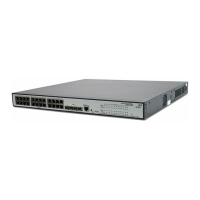188 CHAPTER 15: MULTICAST OVERVIEW
■ All receivers interested in the same information form a multicast group.
Multicast groups are not subject to geographic restrictions.
■ A router that supports Layer 3 multicast is called multicast router or Layer 3
multicast device. In addition to providing multicast routing, a multicast router
can also manage multicast group members.
For a better understanding of the multicast concept, you can assimilate multicast
transmission to the transmission of TV programs, as shown in
Table 141.
n
A multicast source does not necessarily belong to a multicast group. Namely, a
multicast source is not necessarily a multicast data receiver.
A multicast source can send data to multiple multicast groups at the same time,
and multiple multicast sources can send data to the same multicast group at the
same time.
Advantages and
Applications of
Multicast
Advantages of multicast
Advantages of multicast include:
■ Enhanced efficiency: Multicast decreases network traffic and reduces server
load and CPU load.
■ Optimal performance: Multicast reduces redundant traffic.
■ Distributive application: Multicast makes multiple-point application possible.
Application of multicast
The multicast technology effectively addresses the issue of point-to-multipoint
data transmission. By enabling high-efficiency point-to-multipoint data
transmission, over an IP network, multicast greatly saves network bandwidth and
reduces network load.
Multicast provides the following applications:
■ Applications of multimedia and flow media, such as Web TV, Web radio, and
real-time video/audio conferencing.
■ Communication for training and cooperative operations, such as remote
education.
■ Database and financial applications (stock), and so on.
■ Any point-to-multiple-point data application.
Tabl e 141 An analogy between TV transmission and multicast transmission
Step TV transmission Multicast transmission
1 A TV station transmits a TV program
through a television channel.
A multicast source sends multicast data to a
multicast group.
2 A user tunes the TV set to the channel. A receiver joins the multicast group.
3 The user starts to watch the TV
program transmitted by the TV station
via the channel.
The receiver starts to receive the multicast
data that the source sends to the multicast
group.
4 The user turns off the TV set. The receiver leaves the multicast group.

